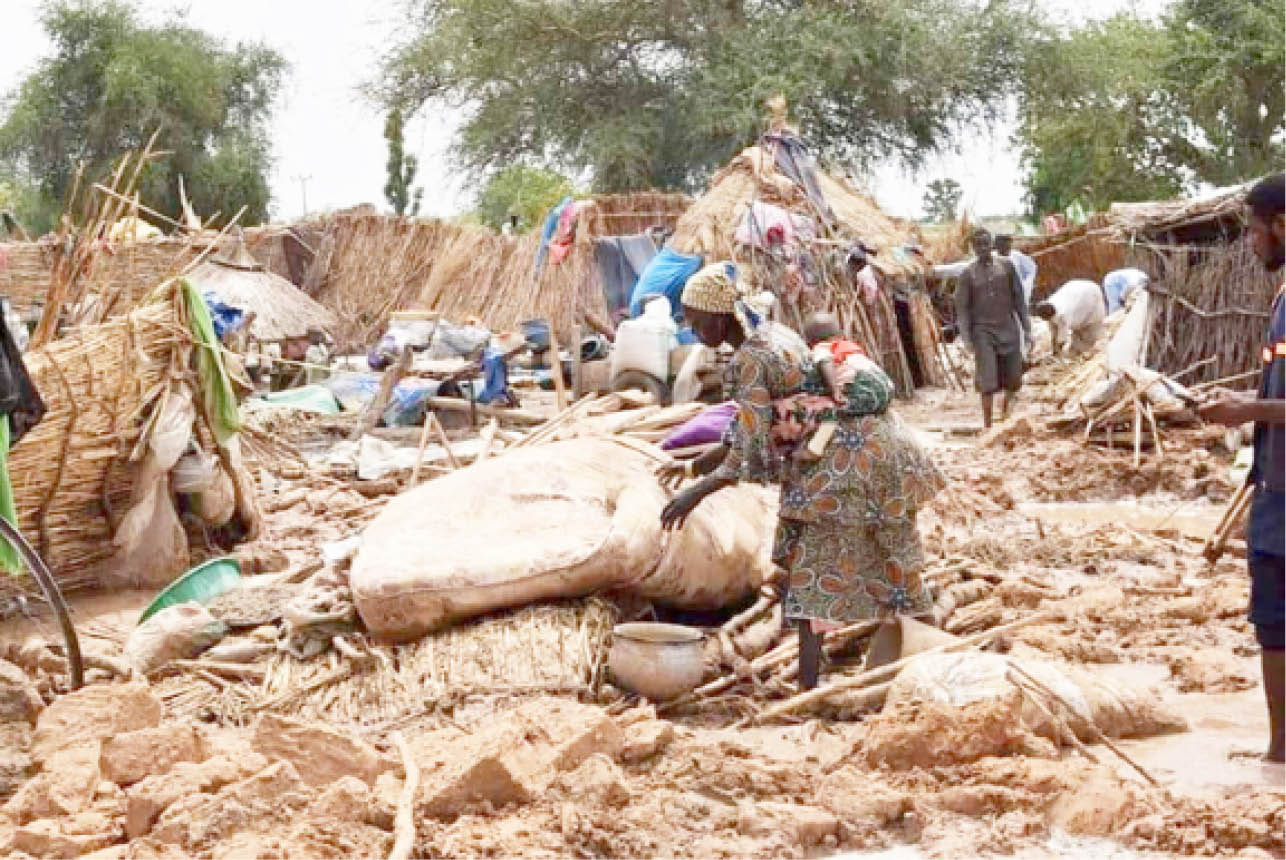Many Nigerians, especially those in states prone to flooding, are living in fear following a prediction by the Nigeria Hydrological Services Agency (NIHSA) which painted a scary picture of likely havoc throughout this year’s rainy season.
Some people who live in red spots told the Daily Trust Saturday that they have resorted to self-self because they don’t want to be caught unawares.
- Canada pledges support for African first ladies’ peace mission
- Why Kidnappings, banditry persist in North
While government officials normally blame residents of not paying attention to early warning signals simply because they want to be compensated in the event the rains wreak havoc on their dwellings, some victims accused those in positions of authority of not doing enough to avert calamities.
In its Annual Flood Outlook (AFO), NIHSA predicted that parts of 121 LGAs in 27 states and the FCT fall within the highly probable flood risk areas, while parts of 302 LGAs in all the 36 states of the federation including the FCT fall within the moderately probable flood risk areas.
It also predicted that probable flood risk area coverage in 2021 is expected to be similar but lower in magnitude to that of 2020.
NIHSA’s prediction, however, aims to sensitise Nigerians on flood management, particularly those living in the coastal and riverine areas, as well as cities and communities along trans boundary rivers on the risk of flooding.
“The 27 highly probable flood risk states are Abia, Akwa-Ibom, Anambra, Bauchi, Bayelsa, Benue, Cross-River, Delta, Ebonyi, Edo, Gombe, Imo, Jigawa, Kaduna, Kano, Kebbi, Kogi, Kwara, Lagos, Nasarawa, Niger, Ogun, Oyo, Rivers, Sokoto, Taraba and Zamfara.
“In addition, some coastal states such as Bayelsa, Delta and Lagos are expected to experience coastal flooding due to rise in sea level and tidal surge and this could impact fishing, habitation, and coastal transportation,” NIHSA said in a summary of the AFO.
The agency said flash and urban floods are expected to occur in major cities and other locations in Birnin Kebbi, Sokoto, Kaduna, Gombe, Yola, Makurdi, Abuja, Lafia, Asaba, Port Harcourt, Yenagoa, Lagos, Ibadan, Abeokuta, Benin City, Oshogbo, Ado-Ekiti, Abakaliki, Awka, Nsukka, Calabar, Owerri, and Kano due to poor drainage systems.
‘Warning not enough’
Maxwell John Ali, who had worked with one of the agencies responsible for flood prediction said Nigeria has never been serious with safety issues.
“We always wait for the floods to happen so that government will release the money to support the victims which rarely gets to them,” he said.
“There is the need for a permanent solution which is building permanent places for locals that are endangered. Government should also not allow them to go back to the danger zones,” he said.
Officials of the National Emergency Management Agency (NEMA) said they have done a lot, including writing to the states government to assist the communities that are vulnerable to flood by relocating the people to nearby safe higher grounds.
We know that some state governments have prepared areas for the relocation. We are calling on those that don’t have to do so for sake of their people. We are also calling on the people in the vulnerable areas not to wait but prepare to relocate as soon as possible to avoid the consequences of the flood,” one of the officials said.
Panic in Rivers
Rivers State is one of the 27 states with high chances of flood according to NIHSA. The forecast has led to apprehension among residents in four local government areas.
The affected areas include Mbiama, Omoku, Ndoni, Egi, Umeda, Ewude, Egbema, Abua, Odua, Joikrama, Egbeda in Ahoada East, Ahoada West and Ogba/Egbema/Ndoni local government areas. Some parts of Port Harcourt and Obio Akpor Local Government Areas are also under threat of flooding.
Some streets in Port Harcourt city such as Ikwerre Road, Diobu, Rumukalagbo, Rumuodomaya, Eneka, Choba, Mgboba/NTA Road, Rumulumeni, and some parts of East-West were recently flooded with many residents displaced and property worth millions of naira destroyed.
Last year, a secondary school student and the only child of her parents drowned in Ahoada. The deceased, who had just taken her SSCE died in the flood that submerged the family’s house.
An environmentalist, Sunny Okocha, blamed some of the devastating flooding on residents who build houses on water channels.
At Oyigbo, some residents have started moving out of their homes for fear of the impending floods. Flood prone areas in the community such as Kom Kom, Umusoya, School Road, Atata, Umunchi, Prelate Streets and High Tension areas are already witnessing tidal flooding just as residents have started relocating to areas less risky.
Meanwhile, the Rivers State Ministry of Environment has started opening drain channels while structures built on water channels have been marked for demolition.
A statement from the ministry stated that the state government is doing everything possible to ensure that residents are not at risk of rampaging floods.

Fear grips Edo, Aba residents
In Edo State, flooding is prevalent in four local government areas: Ikpoba-Okha, Ovia North-East, Esan South-East, Estako Central and Etsako East.
The state government built a flood camp at Ekperi communities for the evacuation of flood victims. Residents of the area said they are not waiting for the intervention of the state and the federal government as they have never made much impact in the past.
One of the residents who gave his name as Isaac said they have resigned to fate and are making efforts to mitigate the impact of flood in their community.
“Due to our past experiences, we don’t wait for the government. We would survive the same way we have been surviving it,” he said.
Many residents of Aba, Abia State, lamented the effects of the flood on their commercial activities, especially near the Ariaria International Market.
Some residents said the situation has been with them for many years, but got worse with the overflowing of the Ifeobara Basin close to Ariaria International market.
They said the 5.6-kilometre drainage built by the Abia State Government at Ifeobara Basin to pump out stormwater from the Ariaria area to the Aba River is not functioning, as the basin has been taken over by weeds.
Bayelsa residents rely on Monkey Bridges
Residents of Bayelsa State have started making preparation to battle the perennial flooding, which they refer to as ‘yearly visitor’ in the area. The rainy season always ends with flooding in some communities.
Some residents from flood-prone areas have already begun to relocate to safer grounds, while those who may not have means to relocate have started constructing what they call ‘Monkey Bridge’ in local parlance.
Monkey Bridge is a small makeshift wooden bridge constructed in the walkway above the ground level during the rainy season to help people cross over the areas that may be covered by the flood.
Areas always affected by the flood in the state include Yenagoa – the state capital, Sagbama, Kolokuma/Okpokuma, and some parts of Southern Ijaw local government areas.
According to experts, the state sits below sea level, and both River Niger and Benue empty into the Atlantic Ocean which crisscrossed the state, hence the reason for the yearly flood in the state.
The peak of flooding in the state is always between August and December when the floodwater begins to recede.
A resident of Igbogene community, Mr Henry Commissioner, who claimed he lost everything to the flood last year, told Daily Trust Saturday that he was yet to recover from the incident.
The Commissioner for Works in the state, Mr Moses Teibowei, said while inspecting the level of flood in some parts of the state that the government has adopted scientific methods in finding solutions to the adverse impact of perennial flooding in the state due to its topography.
Teibowei, who disclosed that Governor Douye Diri had advised researchers at the Niger Delta University to establish an Institute of Flood and Erosion to specifically train manpower in related fields, said the results of the technology-driven solution would be felt from the 2021 flood season.

‘Flood control project ongoing in Akwa Ibom’
Some areas in Uyo, the Akwa Ibom State capital, prone to flood have been a source of concern to both the government and people.
The Commissioner for Environment and Solid Minerals, Mr Charles Udoh, explained that the failure to tackle the problem of flood and erosion especially in the capital city was due to the failure of successive governments to judiciously follow the drainage master plan for Uyo.
Udoh revealed that the constant flood and erosion in the city was caused by houses built on water channels. He said most of the environmental problems the government was tackling in the state are man-made.
“We are building an 8.4-kilometre drain that will take water from Atiku Abubakar Avenue up to the secretariat roundabout, then link it up to the Women Development Centre along IBB way, into Atan Offot up to the PDP secretariat. That drainage will carry 50,000 litres of water per second because of the volume of water around the areas,” he said.
He said the World Bank Assisted Ibrahim Badamosi Babangida (IBB) Avenue drainage project, which cuts across 17 villages in the three local government areas of Uyo, Ibesikpo and Nsit Ibom is expected to solve the over 15-year-old flood challenge at IBB Avenue.
Ogun calls for early harvest, relocation
In Ogun State, residents living in flood-prone areas have expressed anxiety, especially as flash floods had dealt a huge blow on them in the past, destroying property and sometimes, claiming lives.
The flood that occurred last month at Olorunsogo Community, Ijebu Ode, was described by residents as a sign of what to expect at the peak of the rainy season. The state government recently directed residents of flood-prone and wetland areas across about 24 communities to relocate temporarily as part of moves to avert disaster.
Also, farmers around wetland and riverbanks in the communities spread across ten local government areas of the state were asked to harvest their crops before September.
The government said there would be a high intensity of rainfall in September, resulting in fluvial flood, hence, the advice for farmers to avert loss of their livestock and crops to flooding.
The Special Adviser to Governor Dapo Abiodun on Environment, Ola Oresanya, said there was a need for the people to make personal preparation apart from the government’s efforts in order to avert the flood disaster that has been predicted to take place in the state between July and September 2021.
Ekiti SEMA scales up strategies to mitigate flood
The General Manager, Ekiti State Emergency Management Agency, SEMA, Mr Olajide Borode, has said that the agency and other ministries and departments of government are scaling up strategies to mitigate any form of flooding in the state in 2021.
Mr. Borode said sensitization has commenced through advertisement and jingles for members of the public not to dump refuse on waterways in the state.
According to him, the government has started marking houses on waterways for demolition.
The SEMA chief also noted that the government has awarded the contract for the Ajolagun Bridge in Ikere-Ekiti, which has been a danger during flooding.
Borode added that the state government is also making arrangements for relief materials in case of any eventuality.
Nasarawa residents at alert
Residents of Umaisha in Toto Local Government Area of Nasarawa State as well as some communities in Doma and Nasarawa local government areas who live along the River Benue have over the years suffered colossal losses due to flooding.
Investigations by Daily Trust Saturday revealed that villages such as Okpere, Kaita, Idi and others in Umaisha development area of Nasarawa Toto LGA have in the past been submerged by flood.
Narrating their predicament, Mr Musa Salihu said his house was submerged and his farm produce destroyed by flood before the installation of early warning automated system by Governor Abdullahi Sule, which he said would put him on the alert.
Also speaking to our correspondent, a farmer in the area, Mr Ibrahim Gambo, explained that he lost most of his farm produce amounting to N1.8m to flood, noting that the flood also submerged his house.
Meanwhile, the Nasarawa State Government said it has procured relief materials worth millions of naira for those affected by flood disasters in nine local government areas that comprise of Doma, Keana, Karu, Wamba, Awe, Lafia, Obi, Nasarawa, and Toto.
The Executive Secretary of the State Emergency Management Agency (SEMA), Barrister Zachary Allumaga, disclosed that the agency was aware of the alert by NEMA and has embarked on sensitization across the 13 local government areas against blocking, farming, and building on waterways.
In Kaduna, annual flooding due to torrential rainfall often lead to loss of lives and property. In 2020, some homes were submerged in communities such as Hayin Malam Bello, Tudun Wada, Askolaye, Kigo Road, Barnawa, Kudenda, Ungwar Dosa, among others.
Daily Trust Saturday however gathered that most of the affected areas prone to flooding are usually due to blockage of drainages as well as residents building along water channels.
The State Executive Secretary of SEMA, Abubakar Hassan, told our correspondent that preparations to address flooding commenced earlier, adding that the prediction shows that Kaduna North local government has the possibility of witnessing flooding, especially areas very close to water lines and River Kaduna.
He explained that the state government, through some ministries and agencies, has been engaging communities on the human factors that lead to flooding in order to avoid a recurrence of last year’s disaster.
Recurrent decimal in Benue
In Benue State, flooding has remained a perennial concern to residents who usually suffer the devastating effects from year to year. The development had often led to interventions by NEMA which often donated food and non-food items to victims to complement the effort of the state government through SEMA.
Earlier this year, following predictions that the state would likely experience flood in some areas, the Ministry of Environment assured of its preparedness to combat the menace. The state Commissioner of Environment, Dondo Ahire, who was yet to react on the state’s present level of preparedness, had recently said three lives were lost to flooding in the state last year and that more was needed to be done to salvage the situation.
According to him, the ministry under his watch has also stepped-up sensitisation to warn residents about the dangers of obstructing waterways while it distilled drainages to allow free flow of water.
On his part, Executive Secretary of SEMA, Dr Emmanuel Shior, who neither responded to calls or text messages by our correspondent, had posited severally that despite the widespread sensitisation and efforts to stem the tide of flooding, some local government areas were usually affected, hence the need for the regular intervention by NEMA.
We’re helpless, Kwara residents
In Kwara State, some residents around flood-prone areas across the state have expressed helplessness over the perennial flooding, calling on the government to find a permanent solution.
Some of the residents, however, commended government for some preventive actions such as desalting the drainages and sensitization on the indiscriminate dumping of refuse on the canals and waterways.
According to Lukman Oyedeji who lives along Taiwo Isale, one of the flood-prone areas, past attempts to dredge the Asa River brought some temporary relief to the communities, and he urged the government to dredge the river as a permanent solution.
Muinat Abdulrazaq, a resident of Mubo Road, which is also prone to flooding in Ilorin East Local Government Area, indicted both the government and residents, saying the government needs to open up new water channels while residents must stop building on waterways.
Efforts to get the reaction of the state Commissioner for Environment, Mrs Remilekun Banigbe was not successful as she was said to be out of the state. Several calls to her were however not answered.
But the Permanent Secretary of the ministry, Pastor Abraham Kola-Ojo, had blamed the poor attitude of residents towards waste disposal, calling for attitudinal change. He said the ministry is already planning to embark on the clearing of the drainages. ‘’Last year, although we did comprehensive drainage clearing, but by nature of our people, things have returned to the previous state and that is why we are planning to embark on another clearing of the drainages,” he said.
Residents of Lokoja, the Kogi State capital, and environs have expressed fear as the threat of perennial flood with its devastating effects filters in.
They cannot forget in a hurry the flooding witnessed in 2012, which was adjudged the worst in the history of the 30-year-old state. And with every rainy season that approaches, they relive the sad memories of 2012.
In 2015, the administration of Governor Idris Wada constructed an estate that was to take care of flood victims in Lokoja. In Kogi, the nine local government areas that suffer flooding include Lokoja and Kogi (the west), Ajaokuta (central), Igala-Mela, Ibaji, Idah, Bassa, Ofu, and Omala in Kogi east.
In Adankolo axis of Lokoja, Mr Thomas who resides in the area told our correspondent that the marked victims of the annual flood were already bracing up for their yearly enemy. According to him, “We will return to our structures if they survive the flood as long as it lasts because we have no alternative.”
The state Commissioner for Environment, Omofayie Victor could not be reached for comments as he neither answered his calls or text messages sent to him
I-don’t-care attitude in Bauchi
Despite the reoccurrence of flood in Bauchi State, residents, particularly in cities and towns, have continued the culture of indiscriminate dumping of refuse and waste in drainages, culverts, and waterways in many parts of the state.
However, in Adamami village, Shira LGA, residents contributed money to buy hundreds of empty sacks which they filled with sand and placed on flood-prone areas to divert water. The local means of averting flood became necessary after flood submerged the village and destroyed hundreds of houses, crops and farmlands last year.
A victim and resident of Adamami, Mansur Muhammad Adamami, who spoke to our correspondent said that Adamami did not get relief items from the government, making residents to resort to self-help.
Responding, SEMA’s Acting Director Research Planning and Statistics, Adamu Nayola, said that the government distributed relief materials to victims in two categories – those who are vulnerable and lost their houses as well as those who lost their agricultural produce.
On the flood outlook by Nigerian Hydrological Services Agency (NIHSA) in its 2021, Nayola explained that SEMA had commenced public enlightenment to communities in flood-prone areas across the state.
He said, “We also embarked on sensitizing the farmers, especially those farming at edges of major rivers and waterways, to change the crops by planting either sugarcane or varieties of crops that resist quantum of water in the event of a flood.”
In Kano State, one of the highly flood probable states, flood had in 2020 washed away thousands of hectares of farmlands. The state government is already making preparations to avert similar occurrence in eight local government areas.
The Public Relations Officer of the state’s Ministry for Environment, Sanusi Kofar Na’isa, said drainages have been cleared and refuse evacuated from several areas in the state.
“We have already cleared culverts at Fagge and Kwarin Gogau areas; we are done with these areas already, now we are approaching Na’ibawa,” he said, adding that the state had intensified awareness on possible ways of averting the looming danger.
When our reporter visited some of the flood-prone areas in Kano metropolis, he observed heaps of refuse from people’s residences and commercial areas waiting for evacuation.
The state government had recently scrapped the agency saddled with the responsibility of managing refuse – Refuse Management and Sanitation Board (REMASAB), and engaged a private company to take over.
Yobe already a victim
Though Yobe was not included among the highly flood probable states, a flood disaster in June had resulted in the loss of lives and displaced hundreds of families.
Report from the State Emergency Management Agency SEMA indicated that about 17 people died and 81 others were injured in this year’s flood disaster.
In Damaturu, the state capital, communities like Maisandari, Sumsumma, and Pompomari have begun to witness the seasonal flood.
A resident, Aisha Mohammed, said the flood has disconnected them from the main town. She said the water came all the way from southern Damaturu and blocked their access routes to the state capital.
Residents appealed to the government to construct road and drainage to allow for smooth flow of the water to mitigate flooding.
The State Emergency Management Agency (SEMA) disclosed that about 1,160 households affected by the flood this year were profiled for intervention.
The SEMA Executive Secretary, Dr Mohammed Goje, said the agency with support from National Emergency Management Agency (NEMA), has so far delivered first line support to the victims.
There is, however, no preparation against flooding so far in Taraba State by either the state Emergency Management Agency or the National Emergency Management Agency (NEMA), Daily Trust Saturday findings revealed.
Seven local government areas of the state have experienced flood disaster in the past because of their proximity to three major rivers – the Benue, Donga and Taraba rivers.
These local government areas include Lau, Karim-Lamido, Gassol, Ibbi, Ardo-Kola, Wukari and Bali.
The most devastating flood disasters recorded in the state were 2012 and 2019.
During the 2012 flood disaster, over 30 communities were displaced in about 12 local government areas and farm produce worth millions of naira destroyed.
Both the Taraba State Emergency Management Agency (SEMA) and the National Emergency Management Agency (NEMA) have constantly warned riverine communities against building and farming close to the river side but such warnings have not been adhered to.
Daily Trust Saturday gathered that most floodings in Taraba State is caused by the release of water from Lagdo Dam in the Republic of Cameroon into River Benue which crosses the state from Adamawa and passes into Benue and Kogi states.
‘We’ll intervene’
Scores of residents in Nasarawa State who live around the river Benue area have expressed readiness to relocate from flood-prone areas, saying they wouldn’t want to face any consequence of flood disaster in their areas.
Speaking to our correspondent, Mr John Michael said some people have started relocating to safer areas to avoid any eventuality.
Also corroborating this, Mr Ibrahim Adamu said that they have been directed by the state government to evacuate their belongings so as to avert any cases of flood disaster.
The Executive Secretary of the State Emergency Management Agency (SEMA), Barrister Zachary Allumaga said although it was not yet time for the government to intervene in their movement, government would do so when there is a problem.
Reps want urgent actions
The House of Representatives has urged the federal government to make early preparations and take necessary measures to mitigate the impact of flood in communities along the Benue and Niger trough.
This followed the adoption of a motion on notice jointly sponsored by Saidu Mohammed Mustapha, Kwamoti Bitus Laori, Jafaru Ribadu, Shiddi Usman Danjuma, Mohammed Jafaru, Isah Abdulkareem Usman, Mzondu Benjamin Bem and Ari Abdulmumin Mohammed.
Moving the motion at plenary on Thursday, Saidu Mustapha Mohammed noted that flooding has become a recurrent phenomenon in Nigeria, particularly in communities along the Benue and Niger troughs in lower, middle, and upper regions which stretch across Adamawa, Benue, Kogi, Niger and Nasarawa, among others.
He said the report of the Nigerian Metrological Agency (NIMET) Seasonal Rainfall Prediction (SRP) and that of NIHSA had warned of impending flood and the need to make mitigating arrangements.
Mohammed recalled “the horrific experience of 2012 where 1.3 million people were displaced and forced to live in IDP camps across the country despite similar predictions and warnings.”
He said since the establishment of Lagdo Dam in the Cameroun Republic in 1982, communities along Benue-Niger trough have continued to suffer inestimable loss of lives and property.
The lawmaker expressed worries that the 2021 rainy season is approaching its peak and nothing has been put in place to prevent disaster and the attendant humanitarian crisis.
The House, therefore, urged the federal government to adequately prepare a plan for the imminent disaster by stockpiling relief materials to ameliorate the suffering of the victims in good time.
It equally urged the Ecological Fund Office to work out a lasting solution to the ecological problems in flood disaster-prone areas across the country and mandated the Committees on Ecological Fund, Environment, Emergency and Disaster Preparedness, Water Resources, and Internally Displaced Persons and Refugees to assess the level of preparedness of all relevant agencies towards ensuring timely and effective response to victims of disasters.
By Victor Edozie (Port Harcourt), Usman A. Bello (Benin), Bassey Willie (Yenagoa), Linus Effiong (Umuahia), Iniabasi Umo (Uyo), Raphael Ogbonnaiye (Ado-Ekiti), Peter Moses (Abeokuta), Umar Muhammed (Lafia), Mohammed I. Yaba (Kaduna), Hope Abah Emmanuel (Makurdi), Mumini AbdulKareem (Ilorin), Hassan Ibrahim (Bauchi), Adama John (Lokoja), Ibrahim Baba Saleh (Damaturu), Sani Ibrahim Paki (Kano), Magaji lsa Hunkuyi (Jalingo), Taiwo Adeniyi, Itodo Daniel Sule & Maureen Onochie (Abuja)

 Join Daily Trust WhatsApp Community For Quick Access To News and Happenings Around You.
Join Daily Trust WhatsApp Community For Quick Access To News and Happenings Around You.


